August 12 – Coach Charlie Stubbs Speaks to Thibodaux Rotary
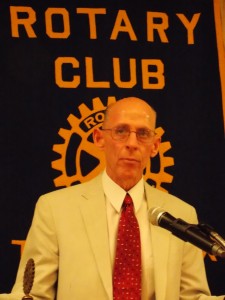 Submitted by Justin Terrebonne
Submitted by Justin Terrebonne
Coach Charlie
Stubbs was the guest speaker at Rotary who discussed the 2014 version of the Nicholls State University Fighting Colonels football team. Coach Stubbs enters his fifth season as head football coach, and thirty-fourth year overall in the coaching profession.
During his time as head football coach, Coach Stubbs has striven to build a program with a solid foundation the “right way.” With five recruiting classes under his leadership, Coach Stubbs’ 2014 team includes seventy one players from the State of Louisiana. He has guided the football program academically from being last in the Southland Conference in APR rankings to the top in both APR ranking and graduation rate. He has also instilled the importance of community, as many players routinely volunteer for community service as opportunities arise.
The theme for the 2014 football season is “Finish,” and starts with five of the first six games on the road. Opening with a trip to the Air Force Academy in Colorado Springs and the University of Arkansas in Fayetteville, this will be the first time the Nicholls State Football team plays a team from the SEC. The first home game is September 13 against Henderson State University and Southland Conference play starts on the road at the University of Central Arkansas on September 27.
In addition to helping fund the budget of the athletic department, Coach Stubbs feels that playing programs from the Football Bowl Subdivision helps in recruiting, as it provides opportunities to play against some of the marque programs in college football.
Chef Randolph Cheramie – Thibodaux Rotary Club
May 28, 2013
By: Amy Connor-Flores
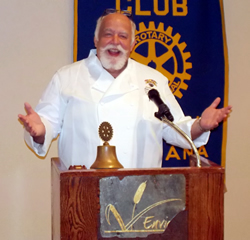 Our rotary club was visited last week by Chef Randolph Cheramie. Chef Randolph grew up in the family-owned Randolph’s Restaurant in Golden Meadow, which was opened by his grandmother and father. In 1981, Chef Randy took over the business and made his own mark on it by specializing in upscale South Louisiana Regional Cuisine.
Our rotary club was visited last week by Chef Randolph Cheramie. Chef Randolph grew up in the family-owned Randolph’s Restaurant in Golden Meadow, which was opened by his grandmother and father. In 1981, Chef Randy took over the business and made his own mark on it by specializing in upscale South Louisiana Regional Cuisine.
For twenty years, Chef Randy enjoyed local and regional acclaim as the hallmark of great food while in charge of Randolph’s. In 1999 he was offered an adjunct professorship teaching Classic French Cuisine at the Chef John Folse Culinary Institute at Nicholls State University. He was asked to join the full-time faculty upon the sale of his restaurant in 2001.
Through the Southern United States Trade Association, Chef Randy has taught some of the top chefs from around the world the art, tradition, culture, and methods of Cajun/Creole, Southern and Soul Food cuisine. He has taught chefs from 38 countries through this program.
Chef Randy coached six American Culinary Federation student hot food teams to five bronze medals and one silver medal in regional competition. He has also coached individual students in the San Pellegrino “Almost Famous Chef” competition in which his students won five consecutive championships and have gone on to the national finals in Napa, California.
Two students coached by Chef Randy have ranked 4th nationally in that competition. In 2011, the American Culinary Federation recognized Chef Cheramie as one of the top 25 chefs in Louisiana, and he is a Certified Food Service Educator. Chef Randy’s knowledge and experience in Southern Regional Cuisine is certainly extensive and focused. He is currently the Executive Director of the Chef John Folse Culinary Institute.
Chef Randy shard with us some of his experiences throughout his years in teaching. He also gave us some insight into the impact that the Chef John Folse Culinary Institute has made at a national level. The Chef is very proud of his students and their ability to compete with others from the top culinary schools in the country. It was a pleasure have him speak to us.
Dr. Jim Barnidge – History Of The Catholic Papacy – Thibodaux Rotary Club
March 12, 2013
By: Jamie Gros
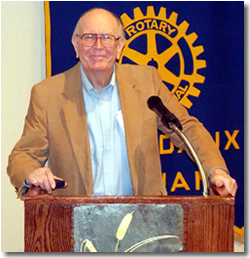 On March 12th, 2013 Dr. Jim Barnidge spoke to Thibodaux’s Rotary Club on the history of the Catholic Papacy.
On March 12th, 2013 Dr. Jim Barnidge spoke to Thibodaux’s Rotary Club on the history of the Catholic Papacy.
Barnidge is a retired history professor from Nicholls State and has spoken to our Rotary club in the past. In fact he was voted speaker of the year for his wealth of knowledge of the crisis in the Middle East. He is also known for attending Europe trips with students and community members for 40 years now.
Given the Catholic Church is going through a change in the Papacy, Barnidge greeted the rotary club with a brief, but entertaining knowledge of the History of the Roman Catholic Church.
Jesus Christ, only taught his teachings, which the Catholic Church is based on for three years. The teachings of Christ were not put onto paper until 3o years after Christ was dead.
It was repeated by word of mouth at first. He set the foundation for his disciples to spread the Word, one of his main disciples Peter is known to have start the church. He actually started churches in several other areas before coming to the main city Rome, where his is ultimately crucified
Peter is not actually crucified in the coliseum, where most events went on in this day and age, he is crucified in what is known as the Circus, which is what Nero the Roman emperor of the time called it. The circuses were literally graveyards, which is what is known today as THE VATICAN, which was the Roman god of the dead.
During this time in the church, before converting to Christianity Peter wanted an individual to become Jewish, it was not until Paul, who was not a Jew, who changed this for the church.
The church slowly developed, its followers waited and waited for the second coming of Christ before they realized the Church needed some organization. There were no real priest at first, but to take care of the needs of their follows they appointed deacons, to take care of the sick and needy.
They also needed someone to take care of correspondence, which was the presbyter, and then someone need to see over them, which were the bishop, above them were the arch bishop and so on and so forth.
The real popularity of Christianity did not start until around the year 300 A.D. Constantine and Maxentius went to war over the Roman Empire. One group of follows was for Maxentius, were sun god worshippers and the other side were followers of Christ; even Constantine was not a Christian himself.
Constantine wins the war and makes December 25th the birth of Christ to deemphasize the sun gods because this was on the winter solstice, the darkest day for these people by also igniting the Birth of the SUN or SON. In many churches today the Saints are depicted with a ray of light behind them or a halo. This was taken from the sun god worshippers.
Constantine saw all the fighting going on and he came up with the Nicene Council to declare the beliefs of Christianity, which is the Nicene Creed, which Catholics still use today in mass. Constantine remained a pagan his whole life until his deathbed, which then he converted to Christianity.
The Catholic Church has been plagued by controversy for years and years. The voting will be done by a group of 115 cardinals, however it can be more but a cardinal cannot vote over the age of 80. There is however, global in balance.
The Latin Church makes up42% of the church population with only 16% of the cardinals; Europe is 24% of the church population and 53% of the population of cardinals, where Africa is 15% of the church population and only 9% of the population of the cardinals.
There is a language barrier located in this it is population. It is very unlikely for a cardinal from the United States become pope. There are many front runners to become the Pope of the Catholic Church; however any adult male who is baptized in the Catholic Church can become pope. But this is very unlikely.
On March 13, 2013 The Roman Catholic Church announced a new pope, First pope from the “New World”, a Jesuit priest, a man of the poor. Cardinal Jorge Mario Bergoglio, Pope Francis I! The new pope will replace Benedict XVI, whose surprise resignation last month prompted the 115 Roman Catholic cardinals to initiate a conclave, a Latin phrase meaning “with a key,” to pick a new leader for the world’s almost 2 billion Catholics.
Dr. Laynie Barrilleaux -Nicholls State University Updates – Thibodaux Rotary Club
January 29, 2013
By: Jamie Gros
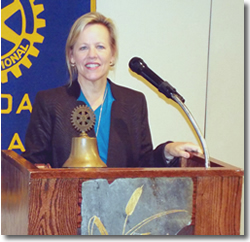 On January 29th, 2013 Dr. Laynie Barrilleaux with Nicholls State University spoke to Rotary on the new updates of the university. Dr. Barrilleaux has served as an active member of Thibodaux Rotary as well as its president. She joined Nicholls as an instructor of management in 1981 and moved through the academic ranks to full professor in 1998.
On January 29th, 2013 Dr. Laynie Barrilleaux with Nicholls State University spoke to Rotary on the new updates of the university. Dr. Barrilleaux has served as an active member of Thibodaux Rotary as well as its president. She joined Nicholls as an instructor of management in 1981 and moved through the academic ranks to full professor in 1998.
During her tenure, she served as head of the department of management and marketing, liaison for the Southern Association of Colleges and Schools (SACS) and assistant vice president for academic affairs. She has led Nicholls through successful reaffirmations of the university-wide regional accreditation and the NCAA recertification. Barrilleaux has been instrumental in securing various grants for the university and has publications in numerous journals.
Barrilleaux announce several updates on the university. The new master’s program in Nursing is starting off very successful and the university has also launched a brand new user friendly website. However, her main goal of the hour was to talk about Nicholls State University Online. Online learning gives the student the ability to attend school and/or study virtually any place, anywhere, and at any time.
This program is geared towards a more specific student. This is a student who has strong computer skills, time management skills. Can learn independently, but ultimately has conflicts with being on campus for classes and presentations. Nicholls Online is a degree that is offered through Nicholls State in a complete online format.
It is currently offering 7 degrees online in an 8 week condensed class session rather than the 16 week semesters. The program is allows students to complete classes more quickly, focus on fewer classes and graduate sooner. However, with Nicholls Online the student is still paying for accredited programs, certified faculty and education with a personal touch. The student also has the ability the extend class up to six months in the event of time restraints. Courses begin every January, March, June, August and October.
With Nicholls online the student has no additional university fees. All undergrad courses are $250 per credit hour and all graduate courses are $350 per credit hour.
Nicholls Online currently offers these degrees:
- Bachelors of Arts in History
- Bachelors of Arts in English
- Bachelors of Arts in Sociology
- Bachelors of Science in General Studies
- Bachelors of Science in general Family and Consumer Science
- Bachelor of Science in Nursing ( for students who have encumbered RN licenses)
- Bachelor of Science in Business Administration
- Masters of Education in Educational Leadership
For those that are interested learning more about the Nicholls Online Program please visit www.nicholls.edu/nicholls-online/
Dr Donald B. Kearns, MD – Part 6 | Thibodaux Rotary Club
The Thibodaux Rotary Club recently had Dr Donald B. Kearns, MD speak as part of an ongoing series “Meet My Cousin.”
Craig Stanga, past president of the Thibodaux Rotary Club, presented Dr Donald B. Kearns, MD – Clinical Professor of Surgery, Head and Neck Surgery Surgeon in Chief, Rady Children’s Specialists of San Diego. Dr Kearns also happens to be Craig’s first cousin.
In Part 6, Dr Kearns shares some innovative approaches for treatments taking place in children’s medicine.
Part 1 – Meet My Cousin – Dr Donald B. Kearns
Part 2 – Meet My Cousin – Dr Donald B. Kearns
Part 3 – Meet My Cousin – Dr Donald B. Kearns
Part 4 – Meet My Cousin – Dr Donald B. Kearns
Dr Donald B. Kearns, MD – Part 5 | Thibodaux Rotary Club
The Thibodaux Rotary Club recently had Dr Donald B. Kearns, MD speak as part of an ongoing series “Meet My Cousin.”
Craig Stanga, past president of the Thibodaux Rotary Club, presented Dr Donald B. Kearns, MD – Clinical Professor of Surgery, Head and Neck Surgery Surgeon in Chief, Rady Children’s Specialists of San Diego. Dr Kearns also happens to be Craig’s first cousin.
Part 5 – The Genomic Revolution .In this segment, Dr Kearns continues his insight into medical innovations.
Part 1 – Meet My Cousin – Dr Donald B. Kearns
Part 2 – Meet My Cousin – Dr Donald B. Kearns
Part 3 – Meet My Cousin – Dr Donald B. Kearns
Part 4 – Meet My Cousin – Dr Donald B. Kearns
Part 5 – Meet My Cousin – Dr Donald B. Kearns
Part 6 – Meet My Cousin – Dr Donald B. Kearns
Dr Donald B. Kearns, MD – Part 4 | Thibodaux Rotary Club
The Thibodaux Rotary Club recently had Dr Donald B. Kearns, MD speak as part of an ongoing series “Meet My Cousin.”
Craig Stanga, past president of the Thibodaux Rotary Club, presented Dr Donald B. Kearns, MD – Clinical Professor of Surgery, Head and Neck Surgery Surgeon in Chief, Rady Children’s Specialists of San Diego. Dr Kearns also happens to be Craig’s first cousin.
In part 4, Dr Kearns shares new developments at Rady Children’s Hospital.
Part 1 – Meet My Cousin – Dr Donald B. Kearns
Part 2 – Meet My Cousin – Dr Donald B. Kearns
Part 3 – Meet My Cousin – Dr Donald B. Kearns
Part 4 – Meet My Cousin – Dr Donald B. Kearns
Part 5 – Meet My Cousin – Dr Donald B. Kearns
Part 6 – Meet My Cousin – Dr Donald B. Kearns
Dr Donald B. Kearns, MD – Part 3 | Thibodaux Rotary Club
The Thibodaux Rotary Club recently had Dr Donald B. Kearns, MD speak as part of an ongoing series “Meet My Cousin.”
Craig Stanga, past president of the Thibodaux Rotary Club, presented Dr Donald B. Kearns, MD – Clinical Professor of Surgery, Head and Neck Surgery Surgeon in Chief, Rady Children’s Specialists of San Diego. Dr Kearns also happens to be Craig’s first cousin.
In part 3, Dr Kearns shares a bit of personal history and new developments at Rady Children’s Hospital.
Part 1 – Meet My Cousin – Dr Donald B. Kearns
Part 2 – Meet My Cousin – Dr Donald B. Kearns
Part 3 – Meet My Cousin – Dr Donald B. Kearns
Part 4 – Meet My Cousin – Dr Donald B. Kearns
Part 5 – Meet My Cousin – Dr Donald B. Kearns
Part 6 – Meet My Cousin – Dr Donald B. Kearns
Dr Donald B. Kearns, MD – Part 1 | Thibodaux Rotary Club
As part of the ongoing Thibodaux Rotary Club series, “Meet My Cousin,” past Rotary Club president, and present Sargent-At-Arms, Craig Stanga presents Dr Donald B. Kearns, MD.
Dr Donald B. Kearns, MD is Clinical Professor of Surgery, Head and Neck Surgery Surgeon in Chief, Rady Children’s Specialists of San Diego. Dr Kearns also happens to be Craig’s first cousin.
In part 1, Craig shares some little known facts about Dr Kearns adolescent years.
Part 1 – Meet My Cousin – Dr Donald B. Kearns
Part 2 – Meet My Cousin – Dr Donald B. Kearns
Part 3 – Meet My Cousin – Dr Donald B. Kearns
Part 4 – Meet My Cousin – Dr Donald B. Kearns
Part 5 – Meet My Cousin – Dr Donald B. Kearns
Part 6 – Meet My Cousin – Dr Donald B. Kearns
Chris Pena – Medical Needs of Soldiers in Southeast LA during the War of the Rebellion
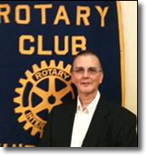 Mr. Pena was born in Houston, Texas and moved to Thibodaux with his family when he was eighteen. Chris is a Nicholls graduate, and earned degrees in theatre, history, and nursing. He holds a Master’s Degree in nursing form the University of Texas He taught nursing at Nicholls for a number of years and is a retired member of the faculty; now resides in Knoxville, Tennessee. Chris is an author, a playwright, an actor, a nurse and a Civil War expert.
Mr. Pena was born in Houston, Texas and moved to Thibodaux with his family when he was eighteen. Chris is a Nicholls graduate, and earned degrees in theatre, history, and nursing. He holds a Master’s Degree in nursing form the University of Texas He taught nursing at Nicholls for a number of years and is a retired member of the faculty; now resides in Knoxville, Tennessee. Chris is an author, a playwright, an actor, a nurse and a Civil War expert.
Mr. Pena talked about the medical problems during the War of the Rebellion: Five battles, fifteen skirmishes, and countless hit and run raids and affairs were staged in the Lafourche district during May 1862 to May 1865 – conservative casualties (killed, wounded, captured or missing) -3,500 – 3,700. Among the five battles only: 230 killed, 631 wounded. Confederates underreported their casualties – for example, Battle of Koch’s Plantation (July 13, 1863) (CSA) Gen. Tom Green listed only 3 killed, 30 wounded. Union reports listed 56 killed, 223 wounded. Chief cause of death was from hemorrhage, and infection from small arms. If wounded in the head, chest or abdomen almost always mortal. doctors used bromine.
Bromine was applied to the surface of the wound or injected into the wound while the patient was under general anesthesia) and iodine (disinfectant) as treatment for wound infections – the problem was that the treatment was started too late. Doctors believed that bacteria came as a result of infections. They didn’t believe that bacteria caused infections. Between 1821 and 1846 only 333 surgeries were performed in USA. Surgery was the last thing opted for because of the pain.
